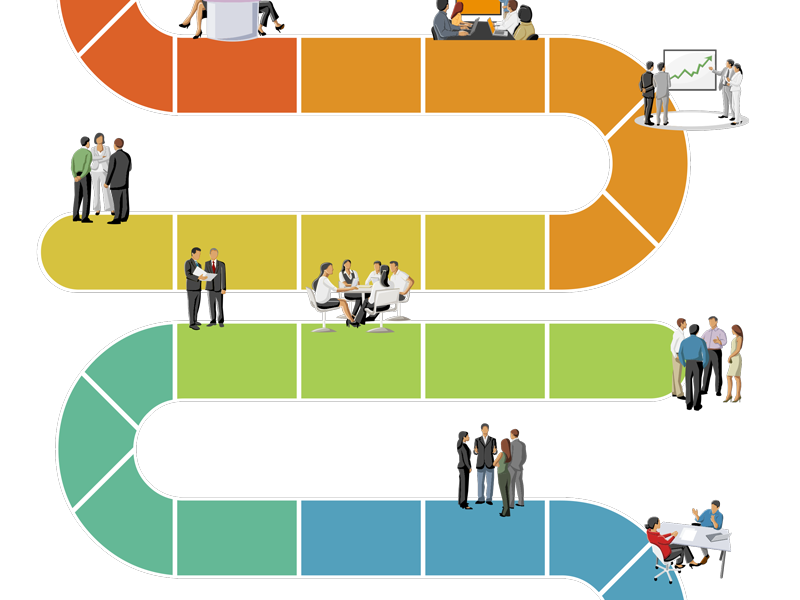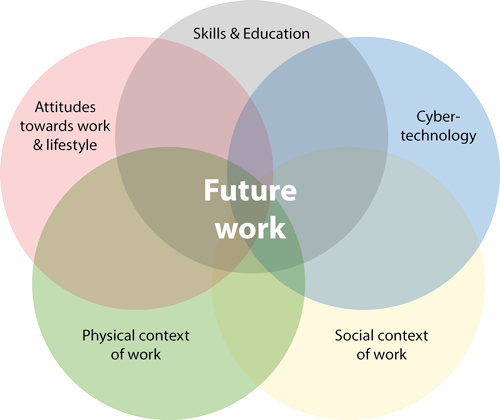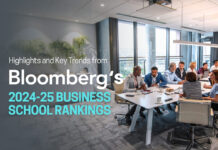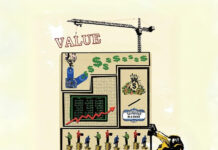Assessing Your Level Of Preparedness In 10 Key Domains1
By Simon L. Dolan, Alex Makarevich and Kristine Marin Kawamura
This article describes 10 key dimensions that executives may use to assess their preparedness for work in Tomorrowland. It offers insightful and strategic questions for leaders to develop people, companies, and ecosystems that are able to flourish in a high tech, high touch, and high growth work reality while resisting the possibilities for strategic implosion.
The world of work is changing. We are in the middle of critical evolutionary and paradigmatic transformations (Raich and Dolan, 2008; Eisler, Dolan, and Raich 2013), which are driven by three powerful forces: globalisation, digitalisation-virtualisation, and creation-innovation (Raich, Eisler and Dolan, 2014). Globalisation is causing people to work midst paradoxical tensions that simultaneously are flattening and rounding, uniting and detaching, the connections between and across organisational ecosystems, stakeholders and resources. Digitalisation is increasing the pace of work; people the world over have instant access to more information, relationships, and inputs than they can easily handle with their time and brain capacities.; the related Virtualisation is weaving a tapestry of handshakes as people work across cultures, boundaries, and borders, demanding trust and near-simulated relationships and environments. As John Naisbitt (author of High Tech/High Touch: Technology and our Search for Meaning) pointed out in 1999, we live in a “technologically-intoxicated zone” that is characterised by a continual search for quick fixes and lives that are distracted and distanced – while causing us to give up the “high touch” aspects of life that give our lives meaning: hope, fear, and longing, love and forgiveness, nature, and spirituality. Roll forward to today, and we see that the greatest demands for jobs are characterised by high tech, high touch, high growth – in industries such as information technology, health care, and education – as well as in opportunities offered by the aging population market segment and demanding entrepreneurship, mathematics, and the sciences (Altman, 2009; Forbes, 2012). And finally, Creation which represent the force for transformation and innovation. The definition of the word “innovation” has subtly changed over the last 30 years. In the 1960s and 1970s innovation was thought of as a process, as the introduction of change. Some, apparently, regarded innovation as simply the generation of a new idea”. Today we imply that any new concept needs to be brought into use before innovation could be said to have taken place. Moreover, in order for innovation to become sustainable and thus embed the concept of transformation, the concept needs to include some measure of success. The latter can be reflected in the words “effectively”, “profitably”, and “satisfied stakeholders”. This hardening of the understanding of the word “innovation” to include the concept of successful commercialisation is probably a result of the increases in business competitiveness, and the developing focus on sustainability, which have occurred in the last 30 years.
Technology that includes information and communication tools has been transforming workplaces the world over for years now and will continue to do so in the future. The development and refinement of new technologies like virtual reality and artificial intelligence have yet to make an impact on the workplace, but there is no doubt that such impact will be profound. New generation of employees entering the labour force in the next decades will differ not only in the level and specialization of knowledge and skills they possess, but also in their work attitudes and preferences for work-life balance. Globalisation, digitalisation, and virtualisation will continue “shrinking” the world at a heightened pace, making work even more portable and detached from geography than we currently experience and understand.
These developments will surely result in changes in how work is done, how companies operate, and how organisations as well as its leaders and managers relate to their employees. As these shifts unfold, they present not only an opportunity for companies to increase their sources of both competitive and cooperative advantage but also the potential risk of strategic implosion – when the breadth, depth, and level of change, of informational and relational inputs simply overwhelms the human capacity to efficiently, effectively, and creatively function. New work principles, practices, and values are needed, today, in order for firms to develop the human, managerial, and organisational capabilities to flourish, if not survive, into the 22nd century (Dolan & Hayashi, 2013).
Zappos, an online shoe retailer, has already begun to embrace the new work order by relying on “Holacracy,” an organisational operating system that replaces today’s top-down predict-and-control paradigm and silo’ed functional structure with a new way of achieving control by distributing power. Based on the principles and practices of self-management and self-organisation, Zappos employees assign agreed-upon roles to each other in team meetings and are required to act more like entrepreneurs and self-direct their work. Customer service employees, for example, receive “surge pay” as they are incentivised to put in more hours when demand for their work is greatest. As of April 30, 2015, in fact, Zappos stated that in order to eliminate the legacy management hierarchy, there would no longer effectively be people managers! What is the goal for these dramatic changes? To improve innovation and productivity as the company continues to grow.
Self-management and self-organisation, by the way, are not new inventions. They describe how life has operated in the world for billions of years, how creatures and ecosystems have been created – the life force of a world that “lives on the edge of chaos with just enough order to funnel its energy, but not so much to slow down adaptation and learning” (Greenfield, 2015). Leading scientists believe that the principle science of the next century, in fact, will be based on the study of complex, autocatalytic, self-organising, non-linear, and adaptive systems – in other words, chaos, or complexity, theory – rather than Newtonian principles (Dolan 2003, Greenfield, 2015). Success and failure of companies in Tomorrowland will be determined by their preparedness for the coming changes in how, when, and why work is done. By adapting to new workplace trends and realities, Zappos and other companies that embrace new ways of working may become better prepared for the work of tomorrow.
But before executives and companies can take action and boost the preparedness of their companies for upcoming changes, they need to evaluate their current level of preparedness for Tomorrowland by identifying areas in which they are most vulnerable and in which they have the greatest advantages. Preparedness will help leaders to excel in Tomorrowland’s world of work; developing people, companies, and ecosystems that are able to flourish in high tech, high touch, and high growth realities and resisting the possibilities for strategic implosion.
The future of work will be shaped by transformation in cyber-technology and the social and physical contexts of work, as well as in attitudes towards work and lifestyle and the skills and education needed for work (See graph below).
Extrapolating from massive data that we have gathered over the years at the Future of Work unit, we argue that executives need to assess their readiness in the following 10 key domains that will be affected by new ways of working:
• The impact of technology and the cyber-age on the future of work and jobs
• The type of work that people will be performing
• Where will people work and what locations they consider desirable
• Work and Non-Work (leisure) combinations: the new mix (balance and integration) of activities in a typical day
• Portfolio employment
• The social context in which work will take place
• The physical context in which work will take place
• The mix of skills and education that knowledge workers will need
• Perspectives on productivity and the factors that contribute to them
• Measures or attributes of Work and life satisfaction
The 10 Areas of Future Work Change
1. The Impact Of Technology And The Cyber-Age On The Future Of Work
While the idea that technology impacts and changes work is as old as the invention of the wheel, commentators agree that the pace of change has been accelerating at an unprecedented speed in recent decades. In 1992, for example, there were less than 14 million Internet users worldwide, compared to nearly 3 billion today.2 Given Moore’s Law, we have more power in our smartphones that provided by the most powerful supercomputers 30 or 40 years ago; Ray Kurzweil, an American author, computer scientist, inventor, and futurist has predicted that the computing power of a $4,000 computer will surpass that of a human brain in 2019 (20 quadrillion calculations per second) (Power, 2015). Virtual reality (VR), already being used in telemedicine through VR headsets, could be extended in the near future to emulate patients so that surgeons could use the technology for training or practicing difficult procedures before trying them on live patients (Enderle, 2015). Artificial intelligence (AI) is used in quantitative modelling, where machine learning is employed to generate thousands of models a week and make decisions in under 15 milliseconds so that a marketer can more accurately place ads that potential consumers are likely to click on.
The consequences of the information revolution afforded by VR and AI and other expert systems will be experienced at an ever-increasing rate in the decades to come, by people contributing to organisations as employees or independent producers. As we enter this “cyber-age,” Raich and his colleagues, as well as Power, argue that more and more jobs will be performed by cyber systems that will replace human employees and create competition for jobs, as only machines can both develop and handle an explosive growth of complex and time-sensitive data while also analysing decisions at a speed, volume, and level of complexity that is too great for humans (Raich, Eisler & Dolan, 2014; Power, 2015). The potential for cyberattacks – including cyberespionage, cyberterrorism, cybercrime and cyberwar – will also greatly increase the need for firms to invest in cybersecurity skills and systems.
Questions that executives need to ask themselves include the following:
• Will new technology replace employees in doing their jobs?
• How will my company’s competitors take advantage of new technologies?
• What shall my company be doing to prevent from losing the technology race to competitors and to take advantage of the new technologies?
• What strategies, risk assessment, control activities, and information and communication management plans must I put in place to address cyber risks?
• What new resources, skills, and knowledge are needed in my company to take advantage of cyber systems rather than to be controlled or eliminated because of them?
• How will my job be affected by cyber systems and the increasing reliance on machine-based data modelling and decision-making?
• How well am I prepared to lead a company relying heavily on cyber systems?
2. The Type Of Work That People Will Be Performing
As these technologies develop and become more refined, ever more complex tasks will be taken over by robots and computers, which will result in another shift in the type of work done by human employees. More jobs will be created in areas where human touch is still necessary (e.g. customer service, occupations related to human emotional states, and the doctor-patient relationship) and in areas that deal with creation, development, and maintenance of new technology.
Questions that executives need to ask themselves include the following:
• Will the development of new technologies eliminate jobs done currently by human employees at my company?
• How shall my company respond if competitors adopt such technologies?
• Is my company positioned well to incorporate technological advances that are likely to emerge in the near future?
• How does this affect my company’s hiring, retaining, and promoting policies?
• How will people’s skills change (becoming more greatly specialised or broadly skilled) in response to the growth of high-productive robotics?
• How will I develop whole-person relationships with people and teams with the heavily reliance on technology-based relationships?
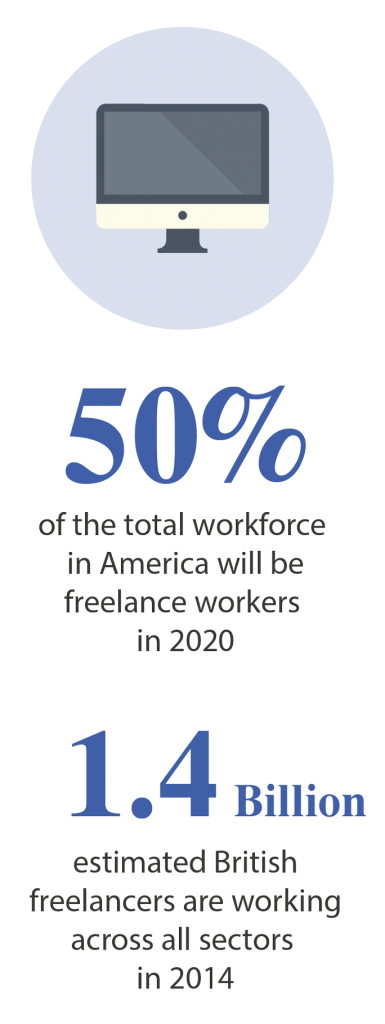 3. Where Will People Work And What Locations They Consider Desirable
3. Where Will People Work And What Locations They Consider Desirable
In recent decades, there has been an unprecedented rise in non-standard forms of work that include flex-time, on-loan, telecommuting, remote work, ‘occasional use flexibility’, job-sharing, and other novel ways of working. The trend towards “freelance work” – contract labour – in America was estimated in 2014 at 53 million, approximately 34 percent of the total workforce, which is expected to balloon to 50 percent by 2020 (Wald, 2014). Correspondingly, there are an estimated 1.4 million British freelancers working across all sectors, a number which has grown 14% in the past decade (Matthews, 2015). Not only bringing billions of freelance earnings to economies, these arrangements allow employees to structure their work time more flexibly and improve their family life, while also providing employees with a choice of location from which work is done.
This trend is powered both by technology that makes virtual work possible and often more efficient and by the changing nature of employment itself (see below on portfolio employment). The rise of the freelance economy illustrates that individuals working from home or other locations of their choice can successfully compete in the global market and can very often do so more efficiently than workers in more traditional settings. Companies that take advantage of these developments are staying ahead of the competition. The successful rise of low cost airlines, as a note, was due in large part to the elimination of costly offices and personnel and a greater reliance on online information and communication tools – a business model that was based on greater detachment from physical places of work than those of their lagging competitors.
Questions that executives need to ask themselves include the following:
• Is my company taking full advantage of technological advancements in how work is conceptualised, distributed, performed, and evaluated?
• Can my company offer a choice of locations for employees to work from in order to increase their flexibility while enhancing their performance at the same time?
• What locations of work do my employees consider desirable, and how can my company increase the match between employees’ preferences for work locations and company needs?
• What work location is personally desirable to me?
• Can I organise my work so that I work from my preferred location without sacrificing effectiveness?
4. Work And Non-Work (Leisure) Combinations: The New Mix (Balance And Integration) Of Activities In A Typical Day
Questions that executives need to ask themselves include the following:
• Is my company allowing employees a mix of activities in a day that allows the company to achieve its goals while contributing to employees’ satisfaction and keeping them motivated?
• What “perks” am I offering to my employees so that I attract and retain my best people? Am I competitive with my offerings?
• How am I viewing my employees as “whole people?” What kind of business and strategic human resource management strategies am I using to increase our social, human, and intellectual capital?
• Is my own mix of daily activities contributing to effective accomplishment of my tasks as an executive? Is my work providing me job, career, and life satisfaction?
5. Portfolio Employment
Rationalisation of work processes by managers and the desire of employees to be staffed on exciting new projects are leading to an increase in work done on a project basis. For employees, simultaneously working on a number of projects is becoming a norm. This trend towards portfolio employment is traversing the boundaries of both occupations and geography. Employees of tomorrow will work more on a project basis as opposed to in a permanent job position for the same employer and in the same sector. They will also change career paths more frequently than in the past and will engage in work outside their geographical locations. The freelance economy is one of the most powerful, unsung forces that is changing society in this decade. By providing a new route to employment for many people who either can’t get a foothold in the traditional employment market – or would prefer to work in a different way – it’s giving them more freedom and control over their destiny. More than 53 million Americans are doing freelance work, according to a recent landmark survey conducted by the independent research firm Edelman Berland and commissioned by Freelancers Union (Wald, in Forbes, 2013). This represent 34 percent of the entire workforce. As technology, efficacy, and employees’ preferences coalesce, more and more sectors will follow.
Questions that executives need to ask themselves include the following:
• Is my company taking full advantage of portfolio-based employment? Are we reaping the benefits in terms of both bottom line efficiency and employee satisfaction?
• Does my company allow employees to work on multiple projects simultaneously?
• What types of employees at my company want and should be allowed to work on project basis?
• Can a project-based mentality be applied successfully to my own tasks as an executive?
• How do I build a psychological contract and emotional contract with these workers?
• How am I using my purpose, vision, values, and mission to attract people that are most aligned with my organisation?
• How am I building values, ethics, and relational/emotional intelligence skills into my human resources and organisational culture and fabric, especially needed given the transformation to portfolio employment?
6. The Social Context In Which Work Will Take Place
New generations of employees not only will be tech-savvy, but also will be accustomed to the impersonal communication associated with social networking, web-based meetings, conferences, and trainings, and the use of high-tech tools like virtual reality and social media. These employees will enter the workplace with habits and communication preferences formed throughout their lives – long before they graduate from college and enter the working world. This will have a profound effect on the social context of work, which will be characterised less by reliance on face-to-face interaction and team meetings and increasingly by solo workers using technology to collaborate with their co-workers virtually and remotely. Over the past five years, in fact, research shows that there has been a huge increase in media use by young people. Five years ago, young people between age 8 and 18 averaged 6.5 hours of media use a day and managed to pack in 8.5 hours of media use through multi-tasking. Five years later, young people average 7.5 hours of media use of day, which accounts for 10.5 hours a day with multi-tasking (Rideout, Foehr, & Roberts, 2010). Specialists have said that technology has positively and negatively impacted our relationships. Though technology has positively improved the speed of communications and increased our access to other people, more people than ever are isolated and lonely, building more shallow relationships and unable to create meaningful and caring ones.
Questions that executives need to ask themselves include the following:
• How does my company allow employees a choice in how they work and communicate, in order to better meet their preferences and our company’s needs?
• How is my company enabling my employees to use self-reliance as they execute their work tasks? What can my company do to increase this choice?
• How can I create context and community in our organisation using social media tools?
• How can employees in my organisation build long term, innovative, and sustainable working relationships with people in our firm and ecosystem?
• How can we use technology in our company and within the working relationships of all our employees and stakeholders without undermining our values?
• How can our employees learn and operate with and from the values of compassion, trust, and care – bridging technology-based relationships with human-based interactions?
• How am I building humanness into our social environment through conversations, face-to-face meetings and team building?
• Am I using the tools and communication styles and tools that are in line with the best contemporary practices?
• How can I turn off technology in order to turn on relationship-development in the old fashioned way?
7. The Physical Context In Which Work Will Take Place
The trends toward flex-location work, portfolio employment, and virtually-based collaboration and communication will have an impact on the physical conditions in which work is done. Offices associated with permanent job positions that have been the staple of the working world for years will increasingly be replaced by shared offices, temporary work facilities (rented for specific events or projects), and co-creation spaces used flexibly by employees who work independently, communicate via ICT, and often work from home, client locations, or on the go. These new physical conditions of work are likely to be highly adaptable for specific and fast-changing needs. This implies that the workspaces of tomorrow will display high utilitarianism; their design and interior space configuration will need to be changed relatively easily. Executives may bid goodbye to that 100-pound statue in their suites and make room for highly- designed co-creation spaces!
Questions that executives need to ask themselves include the following:
• How do the working spaces in my company correspond to the nature of tasks employees perform?
• What changes to the physical conditions of work would improve the match between employee needs and their work objectives?
• How is my company using the full potential of our physical spaces to flexibly adapt to specific and changing work requirements?
• In what ways can my company use its physical work environment to promote or allow employees greater flexibility in how, where, and when their work is done?
• How is my own physical environment contributing to my effective performance as an executive? What needs to change?
8. The Mix Of Skills And Education That Knowledge Workers Will Need
The skills that will be in high demand in the working world of tomorrow will be very different from those needed a generation ago – or even today. According to Daniel Pink, the author of the bestselling A Whole New Mind, “high touch” aptitudes will be in high demand in the near future. He says that high touch consists of “the capacity to detect patterns and opportunities, to create artistic and emotional beauty, and to combine seemingly unrelated ideas into something new.” With the rise of the internet and advent of advanced technologies like AI, instrumental skills like fact finding and task-based skills like accounting, finance, and transactional leadership decision-making will increasingly be relegated to machines. The distinctive human capacity for empathy, emotional intelligence and the identification and creation of meaning will, on the other hand, come to the forefront. Kenneth Robinson also argues that creativity will be the most valued capability in the future.4 Employees of Tomorrowland, therefore, will be more valued for their people-related skills – their abilities to interact interpersonally, to communicate, and to serve customers – than for their task- or motor-based skills or even for their basic skills such as literacy. New leadership and management systems and styles (provided by approaches such as Connective leadership, Coaching by Values, and Emotional and Social Intelligence, et cetera) will be required for leaders to create the organisational cultures, practices, and capabilities that support the development of human potential.
Questions that executives need to ask themselves include the following:
• How well are my company’s hiring practices performing the task of selecting employees with the right skills for the working world of tomorrow?
• Are my company’s retention and promotion practices geared toward rewarding the skills and attitudes that will be instrumental in the future?
• How are we creating cultures, practices, and capabilities that develop and maximize human potential?
• Is my company promoting executives whose outlook (and not only skills and past accomplishments) make them ready to lead the company into the future in the face of upcoming changes?
• How well does my own set of skills prepare me for the world of work that will be markedly different from today?
9. Perspectives On Productivity And The Factors That Contribute To Them
In Tomorrowland, the world of work will value productivity even more than today – as opposed to measures of work effort or employee loyalty. Notions of loyalty were important in the past – in the 20th century – because most companies hired employees on a permanent basis for “9-to-5” jobs.5 In the future, employers will be seeking to gain maximum value from their employees while they are still working with the company or working on a specific project. Because technological advances will relegate most of the company’s logic-based, analysable tasks to robots and computers that can very efficiently perform these tasks, human employees will be pressured to be more productive. As a result, the overall productivity for a company will likely increase – and will need to increase to stay competitive. The focus of productivity will also likely change: from an efficient execution of predetermined tasks to the creative conceptualisation of new tasks and projects that can raise the company’s overall effectiveness, for example, in addressing customer needs. The shift in focus of productivity from efficiency to effectiveness will be based on three pillars: skills, education and innovation capability. Employees who are better capable of contributing to company effectiveness will also enjoy an advantage in the job markets of tomorrow.
As people use technology to raise their level of productivity, however, they will need to avoid some of its risks: distraction and an inability to focus due to their heightened capacity for multi-tasking; a decrease in their ability to listen, given the dependence on screens and words; and the potential decrease in their ability to conceptualise whole strategies and thoughts due to the texting and tweeting of short thoughts and phrases.
Questions that executives need to ask themselves include the following:
• How does my company compare in productivity to industry leaders and closest competitors?
• In what ways can my company increase productivity while taking the cost/benefit ration in check?
• How can we develop a “productivity strategy” that integrates the work of both technology-based systems and people?
• Does my company allow employees to develop skills that contribute to effectiveness-focused productivity?
• Where is my own productivity focused – on tasks that potentially can be performed by technology like AI or the task where technology is not likely to take over?
10. Work And Life Satisfaction In The Future
Questions that executives need to ask themselves include the following:
• Do the jobs that workers perform in my company contribute to their life satisfaction?
• Do these jobs create meaning and allow workers and employees to realise their full potential in creating something they care about?
• Are my workers and employees able to pursue their passions? To make a social impact?
• Can my employees develop and apply a set of skills that they value and enjoy?
• Does my job allow me to do what I really care about? How is my life satisfaction affected by my job?
Conclusion
The forces of globalisation, digitalisation, virtualisation and creation are reshaping the world of work. Organisations that are able to guard against the risks and to capitalise on the advantages that these forces are bringing will be prepared for the challenges and opportunities of tomorrow. These organisations will obtain competitive and cooperative advantage and will also operate as “whole” companies that are able to inspire “whole” people to achieve greater work and life satisfaction – as well as face the transformative and paradoxical forces that are changing the future of work. In order to prepare themselves for the future, leaders of today’s companies – small and large, Web-based, cyber-based, and bricks-and-mortar-based, local and global – need first to assess their level of preparedness to operate, compete, and cooperate within the changing world of work.
Simon L. Dolan is the holder of the Future of Work Chair in ESADE Business School, Barcelona. He has a Ph.D. from Carlson Graduate School of Management (The University of Minnesota). He is a prolific writer (with over 62 books in multiple editions and multiple languages) on issues of Work psychology, leadership & Coaching and Culture competences including culture reengineering. Email: simon.dolan@esade.edu
Alex Makarevich is an assistant professor at the department of People Management and Organisation, at ESADE Business School. He holds a Ph.D. in Economic Sociology from Stanford University, a M.Phil from Oxford University, and a M.Sc. from the London School of Economics. He studies how network embeddedness affects organisational performance. Email: alex.makarevich@esade.edu
Kristine Marin Kawamura is Professor of Management at St. Georges University, Grenada and Visiting Professor at the Future of Work Unit at ESADE. She received her Ph.D. at the Drucker-Ito School of Management – Claremont University. She is founder and CEO of Yoomi Consulting Group. She has recently published “Cross Cultural Competence – A Field Guide for Developing Global Leaders and Managers” (Emerlad Publishing – 2015). Email: Kawamura@yahoo.com
Endnotes
1. The three authors form part of the Future of Work Unit in ESADE. They are currently working on the validation of a tool designed to measure the level of preparedness for the future of work. This paper was indirectly supported by the European Union’s Seventh Framework Programme for research, technological development and demonstration, under grant agreement no 613194 (EU-Innovate – ‘Sustainable Lifestyles 2.0)
2. See The World Bank, Data, Internet users (per 100 people), data.worldbank.org/indicator/IT.NET.USER P2?page=6&cid=GPD_44 and The World Bank, Data, Population, total, data.worldbank.org/indicator/SP.POP.TOTL.
3. See Fortune “100 Best Companies to Work for ” at http://fortune.com/best-companies/.
4. See https://www.youtube.com/watch?v=iG9CE55wbtY .
5. See Peter Cappelli’s “Why Good People Can’t Get Jobs (Wharton Digital Press, 2012) and Talent of Demand (HBS Publishing, 2008) books.
References
1. Altman, A. (2009). “The New Work Order: High Tech, High Touch, High Growth.” Times Magazine, May 14. Accessed at http://content.time.com/time/specials/packages/article/0,28804,1898024_1898023_1898101,00.html on May 20, 2015
2. Claburn, T. (2015) “Artificial Intelligence Will Put Us Out Of Work.” Information Week, January 30. Accessed at http://www.informationweek.com/it-life/artificial-intelligence-will-put-us-out-of-work/d/d-id/1318875 on May 20, 2015
3. Dolan S.L., (2003) Understanding and Managing Chaos in Organizations, International Journal of Management 20(1):23-36.
4. Dolan S.L. Hayashi P., (2013) Talenting: Framework and Metaphors for a New Processual Approach to Talent Management, The European Business Review. July. http://www.
europeanbusinessreview.com/?p=1153
5. Dolan, S. L., & Raich, M. (2008). Beyond: Business and Society in Transformation. Basingstoke, UK: Palgrave Macmillan.
6. Eisler R., Dolan, S.L., Raich M., (2013) Leading towards Change of Ethics and Caring: Resisting Temptation and Reaping the Benefits, The European Business Review, November (https://www.europeanbusinessreview.com/?p=735)
7. Enderle, R. (2015). “The Enterprise Impact of Virtual Reality.” Datamation, March 6th. Accessed at mobile.datamation.com on May 20, 2015.
8. Forbes (2012) The Jobs with the brightest future. http://www.forbes.com/sites/jacquelynsmith/2012/02/01/the-jobs-with-the-brightest-future/
9. Greenfield, R. (2015). “Zappos CEO Tony Hsieh: Adopt Holacracy or Leave.” Fast Company. Accessed at http://www.fastcompany.com/3044417/zappos-ceo-tony-hsieh-adopt-holacracy-or-leave on May 24, 2015.
10. Matthews, B. (2015). Freelance Statistics 2015: The Freelance Economy in Numbers.” Accessed at http://benrmatthews.com/freelance-statistics-2015/ on May 24, 2015.
11. Power, B. (2015). “Artificial Intelligence is Almost Ready for your Business.” Harvard Busieness Review. March 19. Accessed at https://hbr.org/2015/03/artificial-intelligence-is-almost-ready-for-business on May 22, 2015.
12. Raich, M., Eisler, R., & Dolan, S. L. (2014). Cyberness: The Future Reinvented. http://www.amazon.com/Cyberness-Future-Reinvented-Mario-Raich-ebook/dp/B00LM9XLJK
13. Rideout, V.J., Foehr, U.G., and Roberts, D.F. (2010). “Generation M2: Media in the Live of 8- to 18- Year Olds.” A Report by Kaiser Family Foundation: Menlo Park,CA.
14. Wald, J., (2013) Forget The Jobs Report — Focus On the Freelance Economy. Forbes 7 of March. Accessed at http://www.forbes.com/sites/groupthink/2013/07/03/forget-the-jobs-report-focus-on-the-freelance-economy/
15 Wald, J. (2014). “5 Predictions for the Freelance Economy in 2015.” Forbes, Nov. 24. Accessed at http://www.forbes.com/sites/waldleventhal/2014/11/24/5-predictions-for-the-freelance-economy-in-2015/on May 24, 2015.


